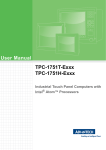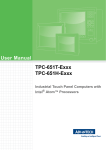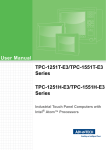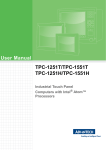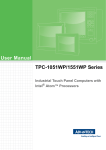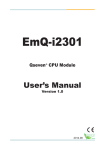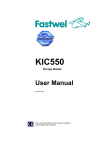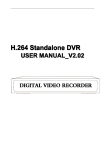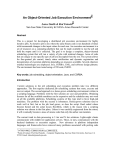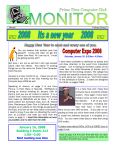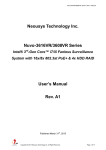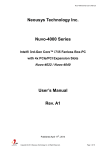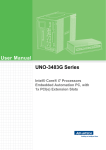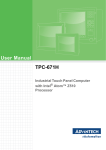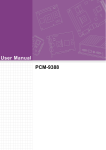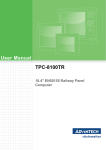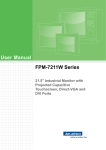Download User Manual IPPC-5211WS Series
Transcript
User Manual IPPC-5211WS Series Industrial Touch Panel Computers with Intel® Celeron™ Processors Copyright The documentation and the software included with this product are copyrighted 2015 by Advantech Co., Ltd. All rights are reserved. Advantech Co., Ltd. reserves the right to make improvements in the products described in this manual at any time without notice. No part of this manual may be reproduced, copied, translated or transmitted in any form or by any means without the prior written permission of Advantech Co., Ltd. Information provided in this manual is intended to be accurate and reliable. However, Advantech Co., Ltd. assumes no responsibility for its use, nor for any infringements of the rights of third parties, which may result from its use. Acknowledgements Intel is a trademark of Intel Corporation. Microsoft Windows and MS-DOS are registered trademarks of Microsoft Corp. All other product names or trademarks are properties of their respective owners. This Manual Covers the Following Model: IPPC-5211WS Series Part No. xxxxxxxxxxxxx Edition 1 Printed in Taiwan July 2015 IPPC-5211WS Series User Manual ii Product Warranty (2 years) Advantech warrants to you, the original purchaser, that each of its products will be free from defects in materials and workmanship for two years from the date of purchase. This warranty does not apply to any products which have been repaired or altered by persons other than repair personnel authorized by Advantech, or which have been subject to misuse, abuse, accident or improper installation. Advantech assumes no liability under the terms of this warranty as a consequence of such events. Because of Advantech’s high quality-control standards and rigorous testing, most of our customers never need to use our repair service. If an Advantech product is defective, it will be repaired or replaced at no charge during the warranty period. For outof-warranty repairs, you will be billed according to the cost of replacement materials, service time and freight. Please consult your dealer for more details. If you think you have a defective product, follow these steps: 1. Collect all the information about the problem encountered. (For example, CPU speed, Advantech products used, other hardware and software used, etc.) Note anything abnormal and list any onscreen messages you get when the problem occurs. 2. Call your dealer and describe the problem. Please have your manual, product, and any helpful information readily available. 3. If your product is diagnosed as defective, obtain an RMA (return merchandize authorization) number from your dealer. This allows us to process your return more quickly. 4. Carefully pack the defective product, a fully-completed Repair and Replacement Order Card and a photocopy proof of purchase date (such as your sales receipt) in a shippable container. A product returned without proof of the purchase date is not eligible for warranty service. 5. Write the RMA number visibly on the outside of the package and ship it prepaid to your dealer. iii IPPC-5211WS Series User Manual Declaration of Conformity CE This product has passed the CE test for environmental specifications when shielded cables are used for external wiring. We recommend the use of shielded cables. This kind of cable is available from Advantech. Please contact your local supplier for ordering information. FCC Class A Note: This equipment has been tested and found to comply with the limits for a Class A digital device, pursuant to part 15 of the FCC Rules. These limits are designed to provide reasonable protection against harmful interference when the equipment is operated in a commercial environment. This equipment generates, uses, and can radiate radio frequency energy and, if not installed and used in accordance with the instruction manual, may cause harmful interference to radio communications. Operation of this equipment in a residential area is likely to cause harmful interference in which case the user will be required to correct the interference at his own expense. Technical Support and Assistance 1. 2. Visit the Advantech web site at http://support.advantech.com where you can find the latest information about the product. Contact your distributor, sales representative, or Advantech's customer service center for technical support if you need additional assistance. Please have the following information ready before you call: – Product name and serial number – Description of your peripheral attachments – Description of your software (operating system, version, application software, etc.) – A complete description of the problem – The exact wording of any error messages IPPC-5211WS Series User Manual iv Safety Instructions 1. 2. 3. Read these safety instructions carefully. Keep this User Manual for later reference. Disconnect this equipment from any AC outlet before cleaning. Use a damp cloth. Do not use liquid or spray detergents for cleaning. 4. For plug-in equipment, the power outlet socket must be located near the equipment and must be easily accessible. 5. Keep this equipment away from humidity. 6. Put this equipment on a reliable surface during installation. Dropping it or letting it fall may cause damage. 7. The openings on the enclosure are for air convection. Protect the equipment from overheating. DO NOT COVER THE OPENINGS. 8. Make sure the voltage of the power source is correct before connecting the equipment to the power outlet. 9. Position the power cord so that people cannot step on it. Do not place anything over the power cord. 10. All cautions and warnings on the equipment should be noted. 11. If the equipment is not used for a long time, disconnect it from the power source to avoid damage by transient overvoltage. 12. Never pour any liquid into an opening. This may cause fire or electrical shock. 13. Never open the equipment. For safety reasons, the equipment should be opened only by qualified service personnel. 14. If one of the following situations arises, get the equipment checked by service personnel: The power cord or plug is damaged. Liquid has penetrated into the equipment. The equipment has been exposed to moisture. The equipment does not work well, or you cannot get it to work according to the user's manual. The equipment has been dropped and damaged. The equipment has obvious signs of breakage. 15. DO NOT LEAVE THIS EQUIPMENT IN AN ENVIRONMENT WHERE THE STORAGE TEMPERATURE MAY GO BELOW -20° C (-4° F) OR ABOVE 60° C (140° F). THIS COULD DAMAGE THE EQUIPMENT. THE EQUIPMENT SHOULD BE IN A CONTROLLED ENVIRONMENT. 16. CAUTION: DANGER OF EXPLOSION IF BATTERY IS INCORRECTLY REPLACED. REPLACE ONLY WITH THE SAME OR EQUIVALENT TYPE RECOMMENDED BY THE MANUFACTURER, DISCARD USED BATTERIES ACCORDING TO THE MANUFACTURER'S INSTRUCTIONS. The sound pressure level at the operator's position according to IEC 704-1:1982 is no more than 70 dB (A). DISCLAIMER: This set of instructions is given according to IEC 704-1. Advantech disclaims all responsibility for the accuracy of any statements contained herein. v IPPC-5211WS Series User Manual Caution! Danger of explosion if battery is incorrectly replaced. Replace only with the same or equivalent type recommended by the manufacturer. Dispose of used batteries according to the manufacturer's instructions. Attention! Danger d'explosion si la pile est remplacée de façon incorrecte. Remplacez seulement avec le même type ou équivalent recommandé par le fabricant. disposer des piles usagées selon les instructions du fabricant. IPPC-5211WS Series User Manual vi Contents Chapter 1 General Information ............................1 1.1 1.2 Introduction ............................................................................................... 2 Specifications ............................................................................................ 2 1.2.1 System Kernel............................................................................... 2 1.2.2 I/O Ports........................................................................................ 2 1.2.3 O/S support................................................................................... 2 1.2.4 Safety and Environment................................................................ 3 LCD Specifications.................................................................................... 3 Touchscreen Specifications ...................................................................... 4 Power ........................................................................................................ 4 I/O Ports Arrangement .............................................................................. 4 Figure 1.1 I/O Port Arrangement ................................................. 4 Mounting Type .......................................................................................... 5 1.7.1 VESA mounting............................................................................. 5 1.7.2 Foot system mounting................................................................... 5 1.7.3 Arm system mounting ................................................................... 5 Dimensions ............................................................................................... 6 Figure 1.2 IPPC-5211WS Dimensions ........................................ 6 1.3 1.4 1.5 1.6 1.7 1.8 Chapter 2 System Setup .......................................7 2.1 System Setup............................................................................................ 8 Figure 2.1 Unpack the Package .................................................. 8 Figure 2.2 Power Connector and Power Lines ............................ 9 Figure 2.3 Power Receptor & Button Pin Assignment ................. 9 2.1.1 Installing the Drivers ..................................................................... 9 Transport and Unpacking........................................................................ 10 Mounting Type ........................................................................................ 10 2.3.1 VESA mounting........................................................................... 10 2.3.2 Foot system mounting................................................................. 11 2.3.3 Arm system mounting ................................................................. 12 2.2 2.3 Chapter 3 Features in Windows Embedded .....13 3.1 3.2 3.3 3.4 3.5 Features in Windows Embedded Platform.............................................. 14 Enhanced Write Filter (EWF) .................................................................. 14 File-Based Write Filter (FBWF) ............................................................... 16 HORM ..................................................................................................... 17 UWF ....................................................................................................... 18 Appendix A Serial Port Settings ...........................19 A.1 Jumper, Dip switch and Connector location............................................ 20 A.1.1 Top.............................................................................................. 20 A.1.2 Bottom......................................................................................... 21 Jumper setting and Description............................................................... 22 A.2.1 CMOS Clear Function (CN1) ...................................................... 22 Switch Setting ......................................................................................... 22 A.3.1 Termination Resistor Select (SW3)............................................. 23 Connector Pin Definition ......................................................................... 23 A.4.1 SATA connector (CN12) ............................................................. 23 A.4.2 SATA Power connector (CN13) .................................................. 24 A.2 A.3 A.4 vii IPPC-5211WS Series User Manual A.4.3 A.4.4 A.4.5 A.4.6 A.4.7 A.4.8 A.4.9 Appendix B Mini PCIE slot (MINIPCIE).......................................................... 24 CFast slot (CN14) ....................................................................... 25 Power in connector (CN18) ........................................................ 25 LAN RJ45 connector (CN7,CN8)................................................ 26 USB connector (CN10) ............................................................... 27 COM1 RS232 connector (CN15) ................................................ 27 COM2 RS232/422/485 connector (CN16) .................................. 28 Driver Installation and Configuration.. 29 B.1 B.2 B.3 B.4 B.5 B.6 B.7 B.8 B.9 Intel Chipset Software Installation Utility Installation............................... 30 Intel Graphics Driver Installation ............................................................. 32 LAN Driver Installation ............................................................................ 35 Intel® Trusted Execution Engine Driver Installation................................ 38 Windows 7 USB 3.0 Driver Installation ................................................... 42 Advantech EC Driver Installation ............................................................ 45 Advantech EC Brightness Control Tool Installation ................................ 47 Advantech EC Watchdog Timer Driver Installation................................. 49 Advantech LMsensor Driver Installation ................................................. 53 Appendix C BIOS Setup ........................................ 55 C.1 C.2 Introduction ............................................................................................. 56 Entering Setup ........................................................................................ 56 C.2.1 Main Setup.................................................................................. 57 C.2.2 Advanced BIOS Features Setup................................................. 58 C.2.3 Chipset Configuration ................................................................. 68 C.2.4 Security....................................................................................... 69 C.2.5 Boot ............................................................................................ 70 C.2.6 Save & Exit ................................................................................. 71 IPPC-5211WS Series User Manual viii Chapter 1 1 General Information 1.1 Introduction The IPPC-5211WS 21.5" fully sealed stainless steel multi-touch panel PC is IP69K rated and has a detachable product portfolio designed for OEMs and process manufacturing. It supports special functions via iDoor, iKey and an antenna, and is designed for HMIs which require better performance and functionality of machinelevel interfaces used in Machineto-Machine (M2M), Internet of Things (IoT) etc which require extra protection for hygienic and harsh environments where the intrusion of dust, condensation and water jets is possible. The IPPC-5211WS can also perform a touch shut-down to avoid accidental operation. The detachable accessory module support various mounting types by a flange connection adapter. – VESA system – The arm and foot system IP 69K is the highest standard in waterproofing. The customer can choose front side only or all around with IP69K. All of the IO ports can be locked by screws in order to avoid unintended unplugging during assembly. With the iDoor module, the IO parts can be easily and flexibly expanded. 1.2 Specifications 1.2.1 System Kernel CPU: Intel® Celeron Processor J1900 BIOS: AMI UEFI BIOS VGA: Integrated in Intel® Celeron™ J1900 Ethernet: 10/100/1000Base-T x 2 Watchdog Timer: EC watchdog timer; 1.0 second timeout period Storage: CFast (optional), SSD (optional) 1.2.2 I/O Ports 10/100/1000 Mbps RJ45 x2 RS-232 x 1, RS-232/RS-485/RS-422 x 1 USB 2.0 x 1 USB 3.0 x 1 iDoor x 1(optional) Waterproof Wireless Antenna x 1(optional) 1.2.3 O/S support Microsoft® Windows – Windows Embedded Standard 7 (64bit) – Windows Embedded 8 Standard (64bit) – Windows 7 (32bit/64bit) – Windows 8 (64bit) IPPC-5211WS Series User Manual 2 1.3 LCD Specifications Display Type TFT LED LCD Size 21.5" Maximum Resolution 1920 x 1080 (Full HD) Maximum Colors 16.7M Viewing Angle (CR≥10) 178° /178° Luminance (cd / m2) 300 Contrast Ratio 5000:1 Operating Temperature 0 ~ 60° C (32 ~ 140° F) Backlight Lifetime 50,000 hours Backlight Note! LED There might be several bright or dark pixels on the LCD. This phenomenon is normal in today’s LCD manufacturing. Inspection criteria are following specifications defined by LCD vendor. 3 IPPC-5211WS Series User Manual General Information Safety FCC Class A CE certificated Waterproof standard – The front bezel is compliant with IP69k protection – The all around IP69K protection with detachable accessory Environment Operating Temperature: 0 ~ 50° C (32 ~ 122° F) Storage Temperature: -20 ~ 60° C (-4 ~ 140° F) Humidity: 40°C @ 10~95% relative humidity (non-condensing) Vibration: With CFast: 2 Grms (5~500 Hz) With HDD: 1 Grms (5 ~ 500 Hz) (Operating, random vibration) Chapter 1 1.2.4 Safety and Environment 1.4 Touchscreen Specifications Touch Type: Projected Capacitive Touch Base Glass Construction: Tempered glass Resolution: 4096 x 4096 Light Transmission: 90% ± 3% (Measured by BYK-Gardner) Controller: USB Interface 1.5 Power Input Voltage: 24VDC +/- 20% (the fuse will become an open circuit if the input level exceeds 32 VDC) Typical: 24 VDC @ 1.7Amp for IPPC-5211WS 1.6 I/O Ports Arrangement The arrangement of the I/O ports is shown in Figure 1.1 Figure 1.1 I/O Port Arrangement IPPC-5211WS Series User Manual 4 1.7.1 VESA mounting 1. 2. 3. Please ensure VESA equipment dimension as 100 x 100 mm. Take screws from the accessory box. Insert the screws into every screw holes and fasten them. These screws will push the VESA mounting and fix the unit. 1. 2. 3. Please ensure that the accessory module which is equipped with four parts. a). The first part is the main structure and is in the shape of a triangle. The purpose of this main structure is for connecting between the front panel and the foot system in order to fulfill the various applications in different production lines. b). And there are two circle covers. One is like a pie and another one is like a doughnut. Both of them are very slim but rugged. The diameter of the circle in the upper and lower side of the triangle are exactly the same. Therefore, the two circle covers can be exchanged based on different applications for the arm or foot system. c). The 4th part is the long-trapezoid piece that is used to cover the triangle to make it waterproof for plugging the cable in to the rear of the IO ports of the computer. Assemble the accessory module and a metal tube which customer prepare by themselves. And then, put IPPC-5211WS on the accessory module and insert the screws into every screw holes and fasten them. These screws will push the accessory and fix the unit. 1.7.3 Arm system mounting 1. 2. 3. Please ensure that the accessory module which is equipped with four parts. a). The first part is the main structure and is in the shape of a triangle. The purpose of this main structure is for connecting between the front panel and the arm system in order to fulfill the various applications in different production lines. b). And there are two circle covers. One is like a pie and another one is like a doughnut. Both of them are very slim but rugged. The diameter of the circle in the upper and lower side of the triangle are exactly the same. Therefore, the two circle covers can be exchanged based on different applications for the arm or foot system. c). The 4th part is the long-trapezoid piece that is used to cover the triangle to make it waterproof for plugging the cable in to the rear of the IO ports of the computer. Assemble the accessory module and a metal tube which customer prepare by themselves. And then, put IPPC-5211WS on the accessory module and insert the screws into every screw holes and fasten them. These screws will push the accessory and fix the unit. 5 IPPC-5211WS Series User Manual General Information 1.7.2 Foot system mounting Chapter 1 1.7 Mounting Type 1.8 Dimensions IPPC-5211WS Series Weight: 15.8 kg Dimensions (W x H x D): 555 x 346.5 x 81 (21.85" x 13.64" x 3.19") Figure 1.2 IPPC-5211WS Dimensions IPPC-5211WS Series User Manual 6 Chapter 2 System Setup 2 2.1 System Setup You can easily get IPPC started by following the below steps. 1. Unpack the IPPC package. Check the packing list at the beginning of this manual to make sure all items have been included. Figure 2.1 Unpack the Package Warning! It is suggested to turn OFF system power as you plug in or pull out the memory card, even though the CompactFlash memory is hot swappable. Il est suggéré de désactiver l'alimentation du système que vous branchez ou retirez le carte mémoire, même si la mémoire CompactFlash est remplaçable à chaud. IPPC-5211WS Series User Manual 8 Connect the power connector to the 24 VDC power lines. The power lines can either be of some power adapter or in-house power source. Figure 2.3 Power Receptor & Button Pin Assignment 3. 4. Plug the power lines into the system power receptor. Supply power to the system 2.1.1 Installing the Drivers After installing your system software, you will be able to set up the Ethernet, VGA, and touchscreen functions. All drivers are stored in a CDROM disc entitled “IPPC5211WS” which can be found in your accessory box. The various drivers in the CD-ROM disc have their own text files which help users install the drivers and understand their functions. These files are a very useful supplement to the information in this manual. Note! The drivers and utilities used for the IPPC-5211WS panel PCs are subject to change without notice. If in doubt, check Advantech's website or contact our application engineers for the latest information regarding drivers and utilities. 9 IPPC-5211WS Series User Manual System Setup Figure 2.2 Power Connector and Power Lines Chapter 2 2. 2.2 Transport and Unpacking When accepting a delivery, please check the packaging for visible transport damage and check the delivery for completeness by comparing it with your order. If you notice any shipping damage or inconsistencies between the contents and your order, please inform the responsible delivery service immediately. During transport, the IPPC should be protected from excessive mechanical stress. If the IPPC is transported or stored without packaging, shocks, vibrations, pressure and moisture may impact the unprotected unit. A damaged packaging indicates that ambient conditions have already had a massive impact on the device. Therefore, please use the original packaging during transportation and storage. If the IPPC is transported in cold weather or is exposed to extreme variations in temperature, make sure that moisture (condensation) does not build up on or inside the HMI device. Moisture can result in short-circuits in electrical circuits and damage the device. To avoid that, please store the IPPC in a dry place and bring the IPPC to room temperature before starting it up. If condensation occurs, a delay time of approximately 12 hours must be allowed to make sure the IPPC is completely dry before the IPPC is switched on. 2.3 Mounting Type 2.3.1 VESA mounting 1. 2. 3. Please ensure VESA equipment dimension as 100 x 100 mm. Take screws from the accessory box. Insert the screws into every screw holes and fasten them. These screws will push the VESA mounting and fix the unit. IPPC-5211WS Series User Manual 10 1. 3. 11 IPPC-5211WS Series User Manual System Setup 2. Please ensure that the accessory module which is equipped with four parts. a). The first part is the main structure and is in the shape of a triangle. The purpose of this main structure is for connecting between the front panel and the foot system in order to fulfill the various applications in different production lines. b). And there are two circle covers. One is like a pie and another one is like a doughnut. Both of them are very slim but rugged. The diameter of the circle in the upper and lower side of the triangle are exactly the same. Therefore, the two circle covers can be exchanged based on different applications for the arm or foot system. c). The 4th part is the long-trapezoid piece that is used to cover the triangle to make it waterproof for plugging the cable in to the rear of the IO ports of the computer. Assemble the accessory module and a metal tube which customer prepare by themselves. And then, put IPPC-5211WS on the accessory module and insert the screws into every screw holes and fasten them. These screws will push the accessory and fix the unit. Chapter 2 2.3.2 Foot system mounting 2.3.3 Arm system mounting 1. 2. 3. Please ensure that the accessory module which is equipped with four parts. a). The first part is the main structure and is in the shape of a triangle. The purpose of this main structure is for connecting between the front panel and the arm system in order to fulfill the various applications in different production lines. b). And there are two circle covers. One is like a pie and another one is like a doughnut. Both of them are very slim but rugged. The diameter of the circle in the upper and lower side of the triangle are exactly the same. Therefore, the two circle covers can be exchanged based on different applications for the arm or foot system. c). The 4th part is the long-trapezoid piece that is used to cover the triangle to make it waterproof for plugging the cable in to the rear of the IO ports of the computer. Assemble the accessory module and a metal tube which customer prepare by themselves. And then, put IPPC-5211WS on the accessory module and insert the screws into every screw holes and fasten them. These screws will push the accessory and fix the unit. IPPC-5211WS Series User Manual 12 Chapter 3 3 Features in Windows Embedded 3.1 Features in Windows Embedded Platform IPPC product supports the Windows Embedded platform. This section outlines the important features (EWF, FBWF and HORM), that are provided in WES7, and UWF provided in Windows Embedded 8 Standard. 3.2 Enhanced Write Filter (EWF) Enhanced Write Filter (EWF) and File-Based Write Filter (FBWF) redirect all writes targeted at protected volumes to a RAM or disk cache, called an overlay. The overlay stores changes made to the operating system, but is removed when the device is restarted, restoring the device to its original state. Note that there is no disk-based overlay support for Windows Embedded Standard 7. EWF works at the sector level on protected disks and allows you to commit changes so that they persist when the device is restarted. EWF is useful for thin clients that do not need to store cached information or receive frequent updates. Changes made to a system protected by EWF are stored in one or more layers that represent snapshots in time. Applying changes to an image applies all changes made to the operating system during a specific period of time. Advantech provide utility to operate EWF. Refer below steps if you want to enable. 1. Click Start Menu->All Programs->Advantech->AdvWF and click EWF Utility IPPC-5211WS Series User Manual 14 Click EWF tab, and click “Enable” button 3. After the system is rebooted automatically, EWF enable IPPC-5211WS Series User Manual Features in Windows Embedded 15 Chapter 3 2. 3.3 File-Based Write Filter (FBWF) File-Based Write Filter (FBWF) works at the file level instead of the sector level on protected disks. By default, FBWF protects the whole disk, but selective write through exceptions can be granted to specific files and folders. Writes to folders with writethrough exceptions will be persisted when the device restarts. Advantech provide utility to operate FBWF. Refer below steps if you want to enable 1. Click Start Menu->All Programs->Advantech->AdvWF and click FBWF Utility 2. Move volume you want to protect from “Available Volume” to “Protected Volume” and choose “Write-Through Files and Folders” 3. Click “Apply”, and the system is rebooted automatically. Then FBWF enable. IPPC-5211WS Series User Manual 16 HORM stands for Hibernate Once Resume Many. In HORM environment, a single hibernation file is used to boot the system repeatedly. To set a HORM environment, please follow the steps below. 1. 2. Enable EWF: 1. Run OSLock, and then system reboot automatically. 2. Open those software that customers want to directly use after system resume from hibernation. 3. Hibernate via Advantech HORM utility: 1. 2. 3. 4. 5. Click Start Menu->All Programs->Advantech->AdvWF Select “Enable Hibernation” in “Power Options”. Open AdvWF and enable EWF After the system is rebooted automatically, open AdvWF and click EWF Utility. Click HORM tab, and click “HORM” button. 17 IPPC-5211WS Series User Manual Features in Windows Embedded 3. Make sure EWF is disabled. You can run OSUnLock to disable EWF. Enable hibernation support: Open the command prompt and type “powercfg -h on” Run “power options” in control panel, and then select “Enable Hibernation” in hibernation pane. Chapter 3 3.4 HORM 3.5 UWF Unified Write Filter (UWF) is a sector-based write filter that you can use to protect your storage media. UWF intercepts all write attempts to a protected volume and redirects those write attempts to a virtual overlay. This improves the reliability and stability of your device and reduces the wear on write-sensitive media, such as flash memory media like solid-state drives. You can use Hibernate Once/Resume Many (HORM) or file and registry filtering exclusions with UWF. UWF is a new feature for Windows Embedded 8 Standard, and is not available as part of Windows 8. UWF integrates the functionality previously available in Enhanced Write Filter (EWF), File-Based Write Filter (FBWF), and Registry Filter in Windows Embedded Standard 7. EWF, FBWF, and Registry Filter are also included separately in Windows Embedded 8 Standard, primarily for backward compatibility. IPPC-5211WS Series User Manual 18 Appendix A A Serial Port Settings A.1 Jumper, Dip switch and Connector location A.1.1 Top IPPC-5211WS Series User Manual 20 Appendix A Serial Port Settings A.1.2 Bottom 21 IPPC-5211WS Series User Manual A.2 Jumper setting and Description A.2.1 CMOS Clear Function (CN1) CMOS Clear Function Description This jumper is used to select CMOS Clear Enable/Disable Default (1-2) (2-3) Clear CMOS (1-2) Normal (1-2) Disable (2-3) Enable (Clear CMOS) A.3 Switch Setting COM2 RS232/422/485 mode setting (SW2) COM2 RS232/422/485 mode setting Description This switch is used to select COM2 RS232/422/485 mode setting Default RS232 mode RS232 Mode Bit 1,2,3,4,5 ON Bit 6,7,8,9,10 OFF RS422 Master Mode Bit 1,2,3,4,5,10 OFF Bit 6,7,8,9 ON RS422 Slave Mode Bit 1,2,3,4,5 OFF Bit 6,7,8,9,10 ON IPPC-5211WS Series User Manual 22 Bit 1,2,3,4,5,8,9 OFF Bit 6,7,10 ON A.3.1 Termination Resistor Select (SW3) Termination Resistor Select Description This switch is used to select Termination Resistor (120 ohm) for long distance transmission or device matching. Default Bit1 off & Bit2 off (DATA+ & RX-) DATA+ Pin 1 RX- Pin 2 R_RX+ Pin 3 R_DATA- Pin 4 Default A.4 Connector Pin Definition A.4.1 SATA connector (CN12) 1654004659 Serial ATA 7P 1.27mm 180D(M) DIP WATM-07DBN4A3B83.12 Pin Signal Description 1 GND GND 2 A+ 3 A- Signal Pair A : TX+/(Transmit) 4 GND GND 5 B- 6 B+ Signal Pair B : RX+/ (Receive) 7 GND GND 23 IPPC-5211WS Series User Manual Appendix A Serial Port Settings RS485 Mode A.4.2 SATA Power connector (CN13) 1655000453 WAFER BOX 2.0mm 5P 180D(M) DIP WO/Pb JIH VEI Pin Signal Description 1 +V3.3SATA SATA power output 3.3V/1A 2 +V5SATA SATA power output 5V/1A 3 +V12SATA SATA power output 12V/0.5A 4 GND GND 5 GND GND A.4.3 Mini PCIE slot (MINIPCIE) 1654002538 MINI PCI E 52P 6.8mm 90D SMD AS0B226-S68N7H Supports PCI1.1, PCI1.2 Power Definition Pin Signal Description 52 +3.3Vaux / +3.3V Pin Signal Description PCI1.1 was +3.3V, PCI1.2 was +3.3Vaux 51 Reserved NC NC 50 GND 49 Reserved 48 +1.5V 47 Reserved NC 46 NC NC 45 Reserved NC 44 NC NC 43 The pin to select the Pin 2, 52 power PIN43_MPCIE_ output for +3.3Vaux or +3.3V (PCI1.1 PWRSEL was Reserved and PIC1.2 was GND 42 NC NC 40 GND 38 USB_D+ 36 USB_D- 34 GND 32 SMB_DATA USB serial data interface compliant to the USB 2.0 specification SMBus data signal compliant to the SMBus 2.0 specification 41 +3.3Vaux 39 +3.3Vaux 37 GND 35 GND 33 PETp0 31 PETn0 PCI Express differential transmit pair 30 SMB_CLK 29 GND 28 +1.5V 27 GND 26 GND 25 PERp0 24 +3.3Vaux 23 PERn0 22 PERST# Functional reset to the card 21 GND 20 W_DISABLE # Active low signal. This signal is used by the system to disable radio operation on add-in cards that implement radio fre19 quency applications. When implemented, this signal requires a pull-up resistor on the card. Reserved 18 GND 17 Reserved NC Key Key Key Key 16 NC NC 15 GND 14 NC NC 13 REFCLK+ PCI Express differential receive pair NC 12 NC NC 11 REFCLK- 10 NC NC 9 GND 8 NC NC 7 CLKREQ# 6 1.5V 5 NC NC 4 GND 3 NC NC 2 +3.3Vaux / +3.3V 1 WAKE# Open Drain active Low signal. This signal is used to request that the system return from a sleep/suspended state to service a function initiated wake event. PCI1.1 was +3.3V , PCI1.2 was +3.3Vaux Reference clock request signal * +3.3Vaux was suspend Power , power out to device +3.3V/1.1A * +3.3V was core power * +1.5V was core power, power out to device +1.5V/0.5A IPPC-5211WS Series User Manual 24 1653004849 CFast 24P 1.27mm 90D(M) SMD N7G24-A0B2RA-10-0HTThe host is connected to the CFast Card using a 7+17 pin connector Pin Segment CFast Name Description S1 SATA SGND Ground for signal integrity S2 SATA A+ S3 SATA A- Signal Pair A : TX+/(Transmit) S4 SATA SGND Ground for signal integrity S5 SATA B- S6 SATA B+ Signal Pair B : RX+/ (Receive) S7 SATA SGND Ground for signal integrity Key Key PC1 PWR/CTL CDI NC PC2 PWR/CTL GND GND PC3 PWR/CTL TBD NC PC4 PWR/CTL TBD NC PC5 PWR/CTL TBD NC PC6 PWR/CTL TBD NC PC7 PWR/CTL GND GND PC8 PWR/CTL LED1 CF_PHYRDY LED PC9 PWR/CTL LED2 CF_HDDA LED PC10 PWR/CTL IO1 NC PC11 PWR/CTL IO2 NC PC12 PWR/CTL IO3 NC PC13 PWR/CTL PWR PC14 PWR/CTL PWR PC15 PWR/CTL PGND PC16 PWR/CTL PGND PC17 PWR/CTL CDO CFast Power output to Device +3.3V / 1.2A Ground for Power return NC A.4.5 Power in connector (CN18) 1652003104 PLUG-IN BLOCK 3P 5.08mm 90D(M) DIP ME050-50803 Pin Signal 1 Power IN V+ 2 Power IN V– (GND) 3 GND_EARTH Description 24VDC +-20% Power in The GND_EARTH to connect a Screw hole for short with the chassis GND 25 IPPC-5211WS Series User Manual Appendix A Serial Port Settings A.4.4 CFast slot (CN14) A.4.6 LAN RJ45 connector (CN7,CN8) 1652002996 PHONE JACK RJ45 14P 90D(M) DIP RTA-195AAK1A RJ45 Pin Signal Description 1 MDI0+ 2 3 MDI0- MDI1+ 6 MDI1- 4 MDI2+ 5 MDI2- 7 MDI3+ 8 MDI3- In BASE-T: Media Dependent Interface[0]: 1000BASE-T: In MDI configuration, MDI[0]+/- corresponds to BI_DA+/- and in MDI-X configuration MDI[0]+/corresponds to BI_DB+/-. 10BASE-T and 100BASE-TX: In MDI configuration, MDI[0]+/- is used for the transmit pair and in MDIX configuration MDI[0]+/- is used for the receive pair. In BASE-T: Media Dependent Interface[1]: 1000BASE-T: In MDI configuration, MDI[1]+/- corresponds to BI_DB+ and in MDI-X configuration MDI[1]+/corresponds to BI_DA+/-. 10BASE-T and 100BASE-TX: In MDI configuration, MDI[1]+/- is used for the receive pair and in MDI-X configuration MDI[1]+/- is used for the transmit pair. In BASE-T: Media Dependent Interface[3:2]: 1000BASE-T: In MDI and in MDI-X configuration, MDI[2]+/- corresponds to BI_DC+/- and MDI[3]+/- corresponds to BI_DD+/-. 100BASE-TX: Unused. 10BASE-T: Unused. Left LED Right LED 10Link 100Link 1000 Link Active Off Orange Green Green IPPC-5211WS Series User Manual 26 1654010199 USB Conn. 2.0+3.0 13P 90D(F) DIP UEA1112C-UHS6-4 Pin Signal Description 1, 10 USB VBUS USB Power output ,USB2.0 5V/0.5A and USB3.0 5V/0.9A 2, 11 USB_P- USB2.0 date - 3, 12 USB_P+ USB2.0 date + 4,13 GND Ground for Power return 5 SSRX- USB3.0 RX - 6 SSRX+ USB3.0 RX + 7 GND_DRAIN Ground for signal return 8 SSTX- USB3.0 TX - 9 SSTX+ USB3.0 TX + A.4.8 COM1 RS232 connector (CN15) 1654000056 D-SUB Conn. 9P 90D(M) DIP 070241MR009S200ZU Pin RS232 1 DCD 2 RX 3 TX 4 DTR 5 GND 6 DSR 7 RTS 8 CTS 9 RI 1 2 6 3 7 4 8 5 9 27 IPPC-5211WS Series User Manual Appendix A Serial Port Settings A.4.7 USB connector (CN10) A.4.9 COM2 RS232/422/485 connector (CN16) 1654000056 D-SUB Conn. 9P 90D(M) DIP 070241MR009S200ZU Pin RS232 RS422 RS485 1 DCD TX- D- 2 RX TX+ D+ 3 TX RX+ 4 DTR RX- 5 GND GND 6 DSR 7 RTS 8 CTS 9 RI 1 2 6 IPPC-5211WS Series User Manual 3 7 28 4 8 GND 5 9 Appendix B B Driver Installation and Configuration B.1 Intel Chipset Software Installation Utility Installation Follow the steps below to install the Intel Chipset Software Installation Utility: 1. Launch <Driver Root Path>\Intel Chipset Software Installation Utility\SetupChipset_XX.X.XX_PV 2. Install SetupChipset.exe 3. Click Next IPPC-5211WS Series User Manual 30 Click Accept 5. Click Install 6. Click Finish Appendix B Driver Installation and Configuration 4. 31 IPPC-5211WS Series User Manual B.2 Intel Graphics Driver Installation Follow the steps below to install the Intel Graphics driver: 1. Launch folder <Driver Root Path>\Graphics Driver\Intel EMGD win7 XX bit\ 2. Install Setp.exe 3. Click Next IPPC-5211WS Series User Manual 32 Click Yes 5. Click Next 6. Click Install Appendix B Driver Installation and Configuration 4. 33 IPPC-5211WS Series User Manual 7. Click Next 8. Choose Yes, then click Finish to restart IPPC-5211WS Series User Manual 34 Follow the steps below to install the LAN driver: 1. Launch folder <Driver Root Path>\LAN\Win7 \Install_Win7_XXX_XXXXXXXX 2. Install setup.exe 35 IPPC-5211WS Series User Manual Appendix B Driver Installation and Configuration B.3 LAN Driver Installation 3. Click Next 4. Click Install IPPC-5211WS Series User Manual 36 Appendix B Driver Installation and Configuration Click Finish 5. IPPC-5211WS Series User Manual 37 B.4 Intel® Trusted Execution Engine Driver Installation Follow the steps below to install the Intel Trusted Execution Engine driver: 1. Launch folder <Driver Root Path>\TXE\Intel TXE Firmware\Win7 2. Install kmdf-1.11-Win-6.1-x64.msu 3. Click Yes IPPC-5211WS Series User Manual 38 Click Restart Now, then the system will restart 5. Launch folder <Driver Root Path>\TXE\TXE_Win7_X_X.X_X.X.X.XXXX 6. Install SetupTXE.exe 39 IPPC-5211WS Series User Manual Appendix B Driver Installation and Configuration 4. 7. Click Next 8. Click Next 9. Click Next IPPC-5211WS Series User Manual 40 41 Appendix B Driver Installation and Configuration 10. Choose Yes, then click Finish to restart. IPPC-5211WS Series User Manual B.5 Windows 7 USB 3.0 Driver Installation Follow the steps below to install the Windows 7 USB 3.0 driver: 1. Launch folder <Driver Root Path>\USB3\Win7\SetupUSB3_X.X.X.XX 2. Install Setup.exe 3. Click Next IPPC-5211WS Series User Manual 42 Click Yes 5. Click Next 6. Click Next Appendix B Driver Installation and Configuration 4. 43 IPPC-5211WS Series User Manual 7. Choose Yes, then click Finish to restart IPPC-5211WS Series User Manual 44 Follow the steps below to install the EC drivers: 1. 2. Launch folder <Driver Root Path>\EC\Vx.xx.xxxx Install AdvEC_Vx.xx.xxxx.exe 3. Click Next 45 IPPC-5211WS Series User Manual Appendix B Driver Installation and Configuration B.6 Advantech EC Driver Installation 4. Click Install 5. Click Finish 6. Choose Yes, then click OK to restart IPPC-5211WS Series User Manual 46 Note! The Advantech EC driver must be installed first Follow the steps below to install the EC brightness control tool: 1. Launch folder <Driver Root Path>\EC Brightness\Vx.xx.xxxx 2. Install AdvECBrightness_Vx.xx.xxxx.exe 3. Click Next 47 IPPC-5211WS Series User Manual Appendix B Driver Installation and Configuration B.7 Advantech EC Brightness Control Tool Installation 4. Click Install 5. Click Finish 6. Choose Yes, then click OK to restart IPPC-5211WS Series User Manual 48 Note! The EC driver must be installed first Follow the steps below to install the EC Watchdog Timer driver: 1. Launch folder <Driver Root Path>\WDT\Vx.xx.xxxx 2. Install AdvWDT_Vx.xx.xxxx.exe 49 IPPC-5211WS Series User Manual Appendix B Driver Installation and Configuration B.8 Advantech EC Watchdog Timer Driver Installation 3. Click Next 4. Choose Advantech [EC]WDT, then click Next IPPC-5211WS Series User Manual 50 Click Install 6. Click Finish Appendix B Driver Installation and Configuration 5. 51 IPPC-5211WS Series User Manual 7. Choose Yes, then click OK to restart IPPC-5211WS Series User Manual 52 Follow the steps below to install the LMsensor driver: 1. Launch folder <Driver Root Path>\Lmsensor\Vx.xx.xxxx 2. Install AdvLmsensor_EC_Vx.xx.xxxx.exe 3. Next 4. Restart Note! The drivers and utilities used for the panel PCs are subject to change without notice. If in doubt, check Advantech's website or contact our application engineers for the latest information regarding drivers and utilities. 53 IPPC-5211WS Series User Manual Appendix B Driver Installation and Configuration B.9 Advantech LMsensor Driver Installation IPPC-5211WS Series User Manual 54 Appendix C BIOS Setup C C.1 Introduction AMI BIOS has been integrated into many motherboards for over a decade. With the AMI BIOS Setup program, users can modify BIOS settings and control various system features. This chapter describes the basic navigation of the BIOS Setup Utility AMI's BIOS ROM has a built-in Setup program that allows users to modify the basic system configuration. This information is stored in flash ROM so it retains the Setup information when the power is turned off. C.2 Entering Setup Turn on the computer and check for the patch code. If there is a number assigned to the patch code, it means that the BIOS supports your CPU. If there is no number assigned to the patch code, please contact an Advantech application engineer to obtain an up-to-date patch code file. This will ensure that your CPU's system status is valid. After ensuring that you have a number assigned to the patch code, press <DEL> and you will immediately be allowed to enter Setup. IPPC-5211WS Series User Manual 56 When you first enter the BIOS Setup Utility, users will enter the Main setup screen. Users can always return to the Main setup screen by selecting the Main tab. There are two Main Setup options. They are described in this section. The Main BIOS Setup screen is shown below. The Main BIOS setup screen has two main frames. The left frame displays all the options that can be configured. Grayed-out options cannot be configured; options in blue can. The right frame displays the key legend. Above the key legend is an area reserved for a text message. When an option is selected in the left frame, it is highlighted in white. Often a text message will accompany it. System time / System date Use this option to change the system time and date. Highlight System Time or System Date using the <Arrow> keys. Enter new values through the keyboard. Press the <Tab> key or the <Arrow> keys to move between fields. The date must be entered in MM/DD/YY format. The time must be entered in HH:MM:SS format. 57 IPPC-5211WS Series User Manual Appendix C BIOS Setup C.2.1 Main Setup C.2.2 Advanced BIOS Features Setup Select the Advanced tab from the setup screen to enter the Advanced BIOS Setup screen. Users can select any item in the left frame of the screen, such as CPU Configuration, to go to the sub menu for that item. Users can display an Advanced BIOS Setup option by highlighting it using the <Arrow> keys. All Advanced BIOS Setup options are described in this section. The Advanced BIOS Setup screens are shown below. The sub menus are described on the following pages. IPPC-5211WS Series User Manual 58 Appendix C BIOS Setup C.2.2.1 ACPI Settings Configuration Enable ACPI Auto Configuration This item allows users to enable or disable BIOS ACPI auto configuration. Enable Hibernation This item allows users to enable or disable System ability to hibernate (OS/S4 sleep State). This option may be not effective with some OS. ACPI Sleep State This item allows users to select the ACPI sleep state. The system will enter when the SUSPEND button is pressed. Lock Legacy Resources Enables or Disables Lock of Legacy Resources 59 IPPC-5211WS Series User Manual C.2.2.2 Super I/O Configuration Serial Port 1 Configuration Set Parameters of Serial Port 1 (COMA) Serial Port 2 Configuration Set Parameters of Serial Port 2 (COMB) C.2.2.3 Embedded Controller Configuration EC Hardware Monitor This page display all information about system Temperature/Voltage/Current. iManager WatchDog IRQ This item allows users to set the IRQ number of EC watchdog. EC Watch Dog Function This item allows users to select EC watchdog timer. IPPC-5211WS Series User Manual 60 Appendix C BIOS Setup C.2.2.4 S5 RTC Wake Settings Wake system with Fixed Time Enable or disable System wake on alarm event. Select FixedTime, system will wake on the hr::min::sec specified. C.2.2.5 Serial Port Console Redirection Console Redirection This item allows users to enable or disable console redirection for Microsoft Windows Emergency Management Services (EMS). Console Redirection This item allows users to configuration console redirection detail settings. 61 IPPC-5211WS Series User Manual C.2.2.6 CPU Configuration Execute Disable Bit This item allows users to enable or disable Execute Disable Bit. XD can prevent certain classes of malicious buffer overflow attacks when combined with a supporting OS. Intel Virtualization Technology This item allows users to enable or disable Intel Virtualization Technology. When enabled, a VMM can utilize the additional hardware capabilities provided by Vanderpool Technology. IPPC-5211WS Series User Manual 62 Appendix C BIOS Setup C.2.2.7 Thermal Configuration Critical Trip Point This value controls the temperature of the ACPI critical Trip Point in which the OS will shut the system off. Passive Trip Point This value controls the temperature of the ACPI critical Trip Point - the point in which OS will begin throttling the processor. 63 IPPC-5211WS Series User Manual C.2.2.8 IDE Configuration Serial-ATA (SATA) This item allows users to enable or disable SATA devices. SATA Test Mode Test Mode enable / disable.. SATA Speed Support Indicates the maximum speed the SATA controller can support. SATA ODD Port SATA ODD is Port0 or Port1. SATA Mode This item allows users to select SATA mode selection. (Determines how SATA controller(s) operate) Serial-ATA Port 0 / Port1 Enable / Disable Serial ATA Port0 / Port1. SATA Port 0 / Port1 HotPlug Enable / Disable SATA Port0 / Port1 hotplug function. Note! Before installing WEC7 image, IDE configuration must set SATA Mode to IDE Mode in BIOS to boot successfully. IPPC-5211WS Series User Manual 64 Appendix C BIOS Setup C.2.2.9 Miscellaneous Configuration OS Selection OS Selection to choose Windows 8.X / Windows 7 / Windows CE 7 C.2.2.10LAN Controller LAN A Controller Enable or disable onboard NIC. LAN B Controller Enable or disable onboard NIC. Wake on LAN Enable Enable/Disable integrated LAN to wake the system 65 IPPC-5211WS Series User Manual C.2.2.11 CSM Configuration CSM Support Enable/Disable CSM Support. GateA20 Active UPON REQUEST - GA20 can be disabled using BIOS services. ALWAYS - do not allow disabling GA20; this option is useful when any RT code is executed above 1 MB. Option ROM Messages Set display mode for Option ROM Boot option filter This option controls Legacy/UEFI ROMs priority Network Controls the execution of UEFI and Legacy PXE OpROM Storage Controls the execution of UEFI and Legacy Storage OpROM Video Controls the execution of UEFI and Legacy Video OpROM Other PCI devices Determines OpROM execution policy for devices other than Network, Storage, or Video IPPC-5211WS Series User Manual 66 Appendix C BIOS Setup C.2.2.12USB Configuration Legacy USB Support Enables support for legacy USB. Auto option disables legacy support if no USB devices are connected. DISABLE option will keep USB devices available only XHCI Hand-Off This is a workaround for OSes without XHCI hand-off support. The XHCI ownership change should claim by XHCI driver. EHCI Hand-Off This is a workaround for OSes without EHCI hand-off support. The EHCI ownership change should claim by EHCI driver. USB Mass Storage Driver Support This item allows you to enable or disable the USB mass storage device support. Device reset time-out USB mass storage device start unit command time-out. Device power-up delay Maximum time the device will take before it properly report itself to the host controller. "Auto" uses default value: for a Root port it is 100 ms, for a Hub port the delay is taken from Hub descriptor. 67 IPPC-5211WS Series User Manual C.2.3 Chipset Configuration Intel IGD Configuration Configure Intel IGD Settings C.2.3.1 Intel IGD Configuration GOP Driver Enable GOP Driver will unload VBIOS; Disable it will load VBIOS. IPPC-5211WS Series User Manual 68 Appendix C BIOS Setup C.2.4 Security Select Security Setup from the main BIOS setup menu. All Security Setup options, such as password protection and virus protection are described in this section. To access the sub menu for the following items, select the item and press <Enter>: Administrator Password Set Administrator Password.. User Password Set User Password.. 69 IPPC-5211WS Series User Manual C.2.5 Boot Setup Prompt Timeout Number of seconds that the firmware will wait before initiating the original default boot selection. A value of 0 indicates that the default boot selection is to be initiated immediately on boot. A value of 65535(0xFFFF) indicates that firmware will wait for user input before booting. This means the default boot selection is not automatically started by the firmware. Bootup NumLock State Select the keyboard NumLock state Quiet Boot Enables or disables Quiet Boot option Fast Boot Enables or disables boot with initialization of a minimal set of devices required to launch active boot option. Has no effect for BBS boot options. Boot Option #1 Sets the system boot order Boot Option #2 Sets the system boot order IPPC-5211WS Series User Manual 70 Appendix C BIOS Setup C.2.6 Save & Exit Save Changes and Exit This item allows you to exit system setup after saving the changes. Discard Changes and Exit This item allows you to exit system setup without saving any changes. Save Changes and Reset This item allows you to reset the system after saving the changes. Discard Changes and Reset This item allows you to rest system setup without saving any changes. Save Changes This item allows you to save changes done so far to any of the options. Discard Changes This item allows you to discard changes done so far to any of the options. Restore Defaults This item allows you to restore/load default values for all the options. Save as User Defaults This item allows you to save the changes done so far as user defaults. Restore User Defaults This item allows you to restore the user defaults to all the options. Boot Override Boot device select can override your boot priority. Launch EFI Shell from files system device Attempts to Launch EFI Shell application (Shell.efi) from one of the available file system devices. 71 IPPC-5211WS Series User Manual www.advantech.com Please verify specifications before quoting. This guide is intended for reference purposes only. All product specifications are subject to change without notice. No part of this publication may be reproduced in any form or by any means, electronic, photocopying, recording or otherwise, without prior written permission of the publisher. All brand and product names are trademarks or registered trademarks of their respective companies. © Advantech Co., Ltd. 2015
















































































